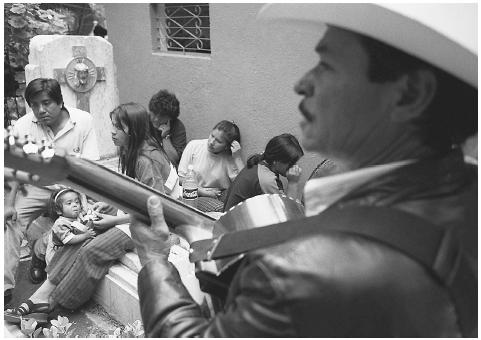Days of the Dead
Days of the Dead, a religious observation celebrated throughout Mexico on November 2, honors the memories of departed family members. The farther south one travels in Mexico, the more elaborate the celebration becomes. It is mainly in southern and central areas where Mexicans decorate their panteones (cemeteries) and the nearby streets with vivid imagery of death, usually skeletons and skulls. Families make altars in their homes, where the photos of departed souls are prominently placed alongside religious icons, ofrendas (offerings) of food such as pan de muertos baked in shapes of skulls and figures, and yellow marigolds, the symbol of death. On the eve of November 2, All Saints Day, some families spend the night at the cemetery in a velada (wake), lighting candles and making offerings at the tombs of their loved ones.
Some communities organize a desfile (parade) with participants dressed up as ghouls, ghosts, mummies, and skeletons carrying an open coffin with an animated corpse played by a villager. The skeletal representations are given feminine nicknames such as la calaca (the skeleton), la pelona (baldy), la flaca (skinny), and la huesada (bony). This most likely originates in the pre-European practice of assigning a female characteristic to the deity overseeing death. The Aztecs called this goddess Mictecacihuatl.
The traveler in the northern or urban areas of Mexico will find no such colorful observances.

There is no doubt that Mexicans demonstrate a unique devotion to a day that all Christians in varying degrees observe. The reasons for this are varied. In areas that retain a vibrant indigenous tradition, this Christian religious holiday is a part of a syncretic process, a blend of pre-Columbian beliefs in the return of the ancestors to their villages and the Christian belief that only the flesh decays but not the soul.
During the Days of the Dead, Mexicans deploy mockery and fraternization to openly confront and accept the inevitability of death that is so feared and hidden in modern Western culture. Considering that contemporary and past pre-industrial cultures deal with death in a similar fashion—there are examples in India, Asia, or Africa—such conviviality in the face of death is a lively tradition in a country where the modern competes with a vigorous traditional past.
In the late nineteenth century, Chicanos and other Americans in the United States have taken to celebrating Days of the Dead with much fanfare. While these projects incorporate the most colorful and interesting features from Mexico, they are usually bereft of the religious dimension of authentic Mexican rites. Interestingly, in the San Francisco Bay area, the homosexual community has taken on this day of observation as a method of coping with the AIDS epidemic.
See also: Afterlife in Cross-Cultural Perspective ; Communication with the Dead ; Ghosts ; Grief and Mourning in Cross-Cultural Perspective
Bibliography
Greenleigh, John. The Days of the Dead: Mexico's Festival of Communion with the Departed. San Francisco: Collins Publishers, 1991.
Hoyt-Goldsmith, Diane. Day of the Dead: A Mexican-American Celebration. New York: Holiday House, 1994.
Luenn, Nancy. A Gift for Abuelita: Celebrating the Day of the Dead. Flagstaff, AZ: Rising Moon, 1998.
F. ARTURO ROSALES
Comment about this article, ask questions, or add new information about this topic: